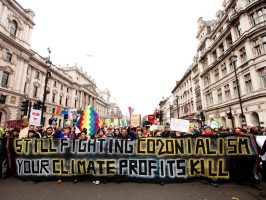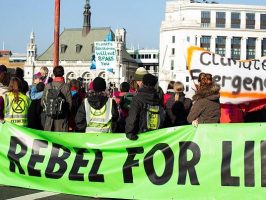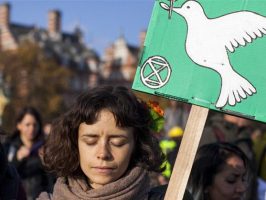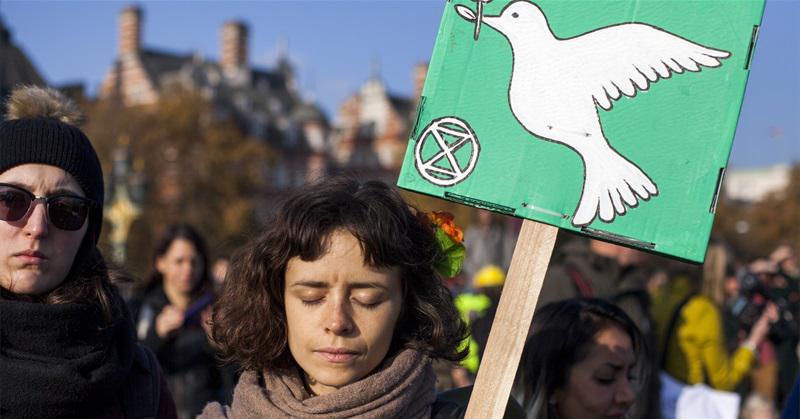[Originally published on Red Pepper:
]
“The fight for climate justice is the fight of our lives, and we need to do it right.” By grassroots collective Wretched of The Earth.
May 3, 2019 · 11 min read

This letter was collaboratively written with dozens of aligned groups. As the weeks of action called by Extinction Rebellion were coming to an end, our groups came together to reflect on the narrative, strategies, tactics and demands of a reinvigorated climate movement in the UK. In this letter we articulate a foundational set of principles and demands that are rooted in justice and which we feel are crucial for the whole movement to consider as we continue constructing a response to the ‘climate emergency’.
Dear Extinction Rebellion,
The emergence of a mass movement like Extinction Rebellion (XR) is an encouraging sign that we have reached a moment of opportunity in which there is both a collective consciousness of the immense danger ahead of us and a collective will to fight it. A critical mass agrees with the open letter launching XR when it states “If we continue on our current path, the future for our species is bleak.”
At the same time, in order to construct a different future, or even to imagine it, we have to understand what this “path” is, and how we arrived at the world as we know it now. “The Truth” of the ecological crisis is that we did not get here by a sequence of small missteps, but were thrust here by powerful forces that drove the distribution of resources of the entire planet and the structure of our societies. The economic structures that dominate us were brought about by colonial projects whose sole purpose is the pursuit of domination and profit. For centuries, racism, sexism and classism have been necessary for this system to be upheld, and have shaped the conditions we find ourselves in.
Another truth is that for many, the bleakness is not something of “the future”. For those of us who are indigenous, working class, black, brown, queer, trans or disabled, the experience of structural violence became part of our birthright. Greta Thunberg calls world leaders to act by reminding them that “Our house is on fire”. For many of us, the house has been on fire for a long time: whenever the tide of ecological violence rises, our communities, especially in the Global South are always first hit. We are the first to face poor air quality, hunger, public health crises, drought, floods and displacement.
XR says that “The science is clear: It is understood we are facing an unprecedented global emergency. We are in a life or death situation of our own making. We must act now.” You may not realize that when you focus on the science you often look past the fire and us – you look past our histories of struggle, dignity, victory and resilience. And you look past the vast intergenerational knowledge of unity with nature that our peoples have. Indigenous communities remind us that we are not separate from nature, and that protecting the environment is also protecting ourselves. In order to survive, communities in the Global South continue to lead the visioning and building of new worlds free of the violence of capitalism. We must both centre those experiences and recognise those knowledges here.
Our communities have been on fire for a long time and these flames are fanned by our exclusion and silencing. Without incorporating our experiences, any response to this disaster will fail to change the complex ways in which social, economic and political systems shape our lives – offering some an easy pass in life and making others pay the cost. In order to envision a future in which we will all be liberated from the root causes of the climate crisis – capitalism, extractivism, racism, sexism, classism, ableism and other systems of oppression – the climate movement must reflect the complex realities of everyone’s lives in their narrative.
And this complexity needs to be reflected in the strategies too. Many of us live with the risk of arrest and criminalization. We have to carefully weigh the costs that can be inflicted on us and our communities by a state that is driven to target those who are racialised ahead of those who are white. The strategy of XR, with the primary tactic of being arrested, is a valid one – but it needs to be underlined by an ongoing analysis of privilege as well as the reality of police and state violence. XR participants should be able to use their privilege to risk arrest, whilst at the same time highlighting the racialised nature of policing. Though some of this analysis has started to happen, until it becomes central to XR’s organising it is not sufficient. To address climate change and its roots in inequity and domination, a diversity and plurality of tactics and communities will be needed to co-create the transformative change necessary.
We commend the energy and enthusiasm XR has brought to the environmental movement, and it brings us hope to see so many people willing to take action. But as we have outlined here, we feel there are key aspects of their approach that need to evolve. This letter calls on XR to do more in the spirit of their principles which say they “are working to build a movement that is participatory, decentralised, and inclusive”. We know that XR has already organised various listening exercises, and acknowledged some of the shortcomings in their approach, so we trust XR and its members will welcome our contribution.
As XR draws this period of actions to a close, we hope our letter presents some useful reflections for what can come next. The list of demands that we present below are not meant to be exhaustive, but to offer a starting point that supports the conversations that are urgently needed.
Wretched of the Earth, together with many other groups, hold the following demands as crucial for a climate justice rebellion:
- Implement a transition, with justice at its core, to reduce UK carbon emissions to zero by 2030 as part of its fair share to keep warming below 1.5°C; this includes halting all fracking projects, free transport solutions and decent housing, regulating and democratising corporations, and restoring ecosystems.
- Pass a Global Green New Deal to ensure finance and technology for the Global South through international cooperation. Climate justice must include reparations and redistribution; a greener economy in Britain will achieve very little if the government continues to hinder vulnerable countries from doing the same through crippling debt, unfair trade deals, and the export of its own deathly extractive industries. This Green New Deal would also include an end to the arms trade. Wars have been created to serve the interests of corporations – the largest arms deals have delivered oil; whilst the world’s largest militaries are the biggest users of petrol.
- Hold transnational corporations accountable by creating a system that regulates them and stops them from practicing global destruction. This would include getting rid of many existing trade and investment agreements that enshrine the will of these transnational corporations.
- Take the planet off the stock market by restructuring the financial sector to make it transparent, democratised, and sustainable while discentivising investment in extractive industries and subsidising renewable energy programmes, ecological justice and regeneration programmes.
- End the hostile environment of walls and fences, detention centers and prisons that are used against racialised, migrant, and refugee communities. Instead, the UK should acknowledge it’s historic and current responsibilities for driving the displacement of peoples and communities and honour its obligation to them.
- Guarantee flourishing communities both in the global north and the global south in which everyone has the right to free education, an adequate income whether in or out of work, universal healthcare including support for mental wellbeing, affordable transportation, affordable healthy food, dignified employment and housing, meaningful political participation, a transformative justice system, gender and sexuality freedoms, and, for disabled and older people, to live independently in the community.
The fight for climate justice is the fight of our lives, and we need to do it right. We share this reflection from a place of love and solidarity, by groups and networks working with frontline communities, united in the spirit of building a climate justice movement that does not make the poorest in the rich countries pay the price for tackling the climate crisis, and refuses to sacrifice the people of the global South to protect the citizens of the global North. It is crucial that we remain accountable to our communities, and all those who don’t have access to the centres of power. Without this accountability, the call for climate justice is empty.
The Wretched of the Earth
Argentina Solidarity Campaign
Black Lives Matter UK
BP or not BP
Bolivian Platform on Climate Change
Bristol Rising Tide
Campaign Against the Arms Trade CAAT
Coal Action Network
Concrete Action
Decolonising Environmentalism
Decolonising our minds
Disabled People Against the Cuts
Earth in Brackets
Edge Fund
End Deportations
Ende Gelände
GAIA – Global Alliance for Incinerator Alternatives
Global Forest Coalition
Green Anticapitalist Front
Gentle Radical
Grow Heathrow/transition Heathrow
Hambach Forest occupation
Healing Justice London
Labour Against Racism and Fascism
Lesbians and Gays Support the Migrants
London campaign against police and state violence
London Feminist Antifa
London Latinxs
Marikana Solidarity Campaign
Mental Health Resistance Network
Migrants Connections festival
Migrants Rights Network
Movimiento Jaguar Despierto
Ni Una Menos UK
Ota Benga Alliance for Peace
Our Future Now
People’s Climate Network
Peoples’ Advocacy Foundation for Justice and
Race on the Agenda (ROTA)
Redress, South Africa
Reclaim the Power
Science for the People
Platform
The Democracy Centre
The Leap
Third World Network
Tripod: Training for Creative Social Action
War on Want
Wretched of The Earth is a grassroots collective for Indigenous, black, brown and diaspora groups and individuals demanding climate justice and acting in solidarity with our communities, both here in the UK and in Global South.











